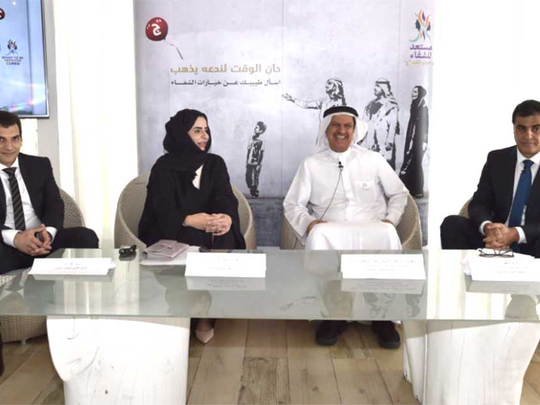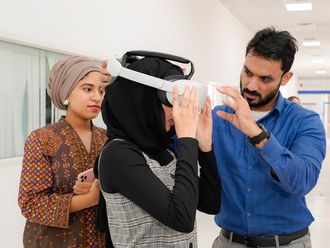
Dubai: A new awareness campaign to help eradicate Hepatitis C Virus (HCV) in the UAE by 2030 was launched on Wednesday, along with a new treatment that provides patients with 95 per cent chance of being cured.
The campaign, ‘Ready to be Hepatitis C Cured’, is being organised by the Ministry of Health and Prevention (MOHAP) in partnership with the Emirates Gastroenterology and Hepatology Society, with the aim of raising awareness about diagnosis and early detection among residents.
The World Health Organisation (WHO) defines Hepatitis C as a liver disease caused by HCV, a virus that can cause both acute and chronic hepatitis, ranging in severity from a mild illness lasting a few weeks to a serious, lifelong illness.
HCV is a blood-borne virus and the most common modes of infection are through exposure to small quantities of blood. This may happen through injection drug use, unsafe injection practices, unsafe health care, and the transfusion of unscreened blood and blood products.
“Although prevalence of HCV in the UAE is less than one per cent, only 30 to 50 per cent of people are diagnosed,” said Dr Hussain Abdul Rahman Al Rand, MOHAP’s assistant undersecretary for Health Centres and Clinics.
He pointed out that with few noticeable symptoms, viral hepatitis represents a considerable public health challenge as many people are either misdiagnosed or do not come forward for testing.
“HCV is recognised as a major cause of liver cirrhosis, end-stage liver disease, and hepatocellular cancer — the most common type of primary liver cancer,” said Dr Al Rand.
The campaign encourages testing for people who fall under specific categories, including individuals who inject drugs, have a tattoo, have received care in countries of high HCV prevalence, haemodialysis patients, and individuals born between 1945 and 1965.
Dr Al Rand pointed out a screening test for HCV is currently mandatory in the UAE for a specific category of jobs, including those in the health care sector as well as manicurists, kindergarten teachers, barbers, and employees working in the restaurant business.
“HCV treatment options have undergone major transformation with the introduction of direct-acting antivirals (DAA), which are highly effective and well tolerated with minimal side effects. These pills were recently introduced in the UAE and are covered by insurance,” he said.
The medication, which consists of pills that are taken for a period of eight to 12 weeks, have proven to have a sustained viral response, reversing the effects of early stage fibrosis, and slowing down the progression of cirrhosis into decompensation.
Sam Kosma, medical director at Gilead Science, a biopharmaceutical company, explained that unlike other chronic conditions such as diabetes and hypertension, which can be controlled, HCV can be cured.
He pointed out that patients who are cured of their HCV infection experience numerous health benefits including “decrease in liver inflammation, halting liver fibrosis progression, and reducing the chance of hepatocellular carcinoma”.
It is estimated that 170 million people are infected with the virus worldwide, but only 30 per cent of people living with it are aware of their condition. The MENA region has the highest prevalence of HCV infection in the world, affecting more than 20 million people in Arab countries. HVC is the seventh leading cause of mortality globally.
Meanwhile, Dr Mariam Al Khatri, president of the Emirates Gastroenterology and Hepatology Society (EGHS), pointed out that among the goals of the UAE becoming among the best countries in the world in terms of quality of health care by 2021, the MOHAP also aims to improve public health and reduce the risk of HCV.
“Many people are often faced with barriers to testing and it links to health care. These barriers often include lack of awareness, knowledge and understanding that can lead to stigma and discrimination,” she said.
Dr Al Khatri pointed out that individuals can easily avoid the health and economic burden and complications of advanced liver disease through early detection.
She referred to the WHO 90-80-90 goal, to help eliminate HCV by 2030. “This can be achieved by ensuring that health care stakeholders diagnose 90 per cent of people living with the virus by 2030, out of which 80 per cent are then treated, and out of which 90 per cent are then cured from the virus,” she said.
The awareness campaign also aims to reach out to residents through social media platforms such as Facebook and Twitter, and a 24-hour WhatsApp support programme for HCV-positive patients.
Groups considered at high risk of HCV infection
People who inject drugs, but are not in a rehab programme
Intranasal drug users
Individuals with tattoos acquired in an unregulated manner
Individuals born between 1945 and 1965
Individuals who have received care in countries of high prevalence of HCV including South East Asia, Egypt, Africa, and South America
Expatriates from other high-risk countries
Individuals transfused before 1992
Haemodialysis patients
Individuals born to HCV-infected mothers
Health care workers
Prisoners
Sexual partners and close family of an HCV-positive patient
Individuals with HIV or HBV infection
Facts and figures
Hepatitis C Virus (HCV) is the seventh leading cause of mortality globally
Around 170 million people are infected with HCV
HCV was responsible for 1.34 million deaths in 2015
HCV is estimated to infect 800,000 people every year in the region
In the World Health Organisation’s Eastern Mediterranean Region, an estimated 21 million people are chronically infected with Hepatitis B and Hepatitis C
According to the Global Burden of Disease database, viral hepatitis B and C cause more deaths in the region than HIV, malaria and tuberculosis together














